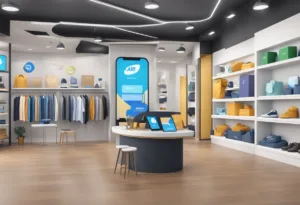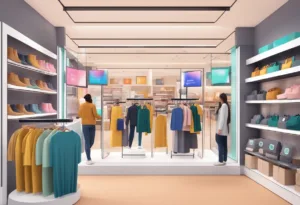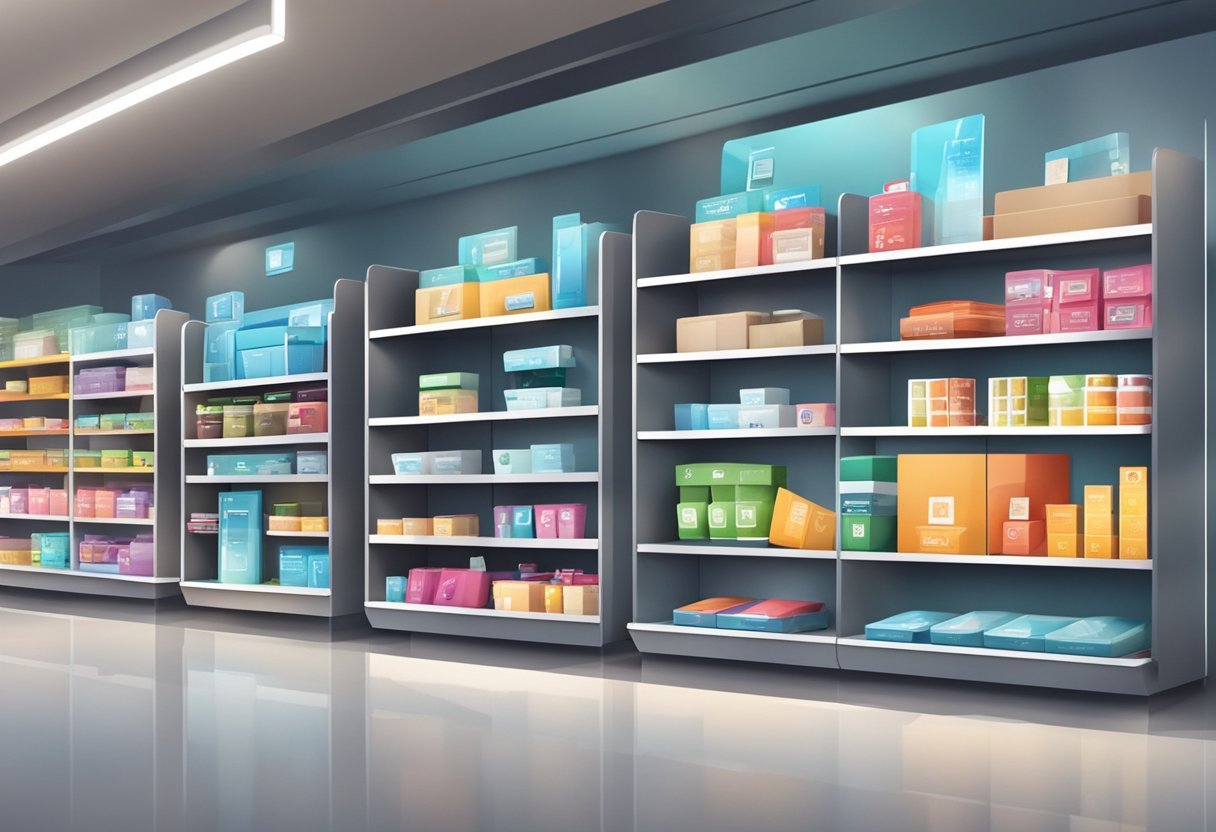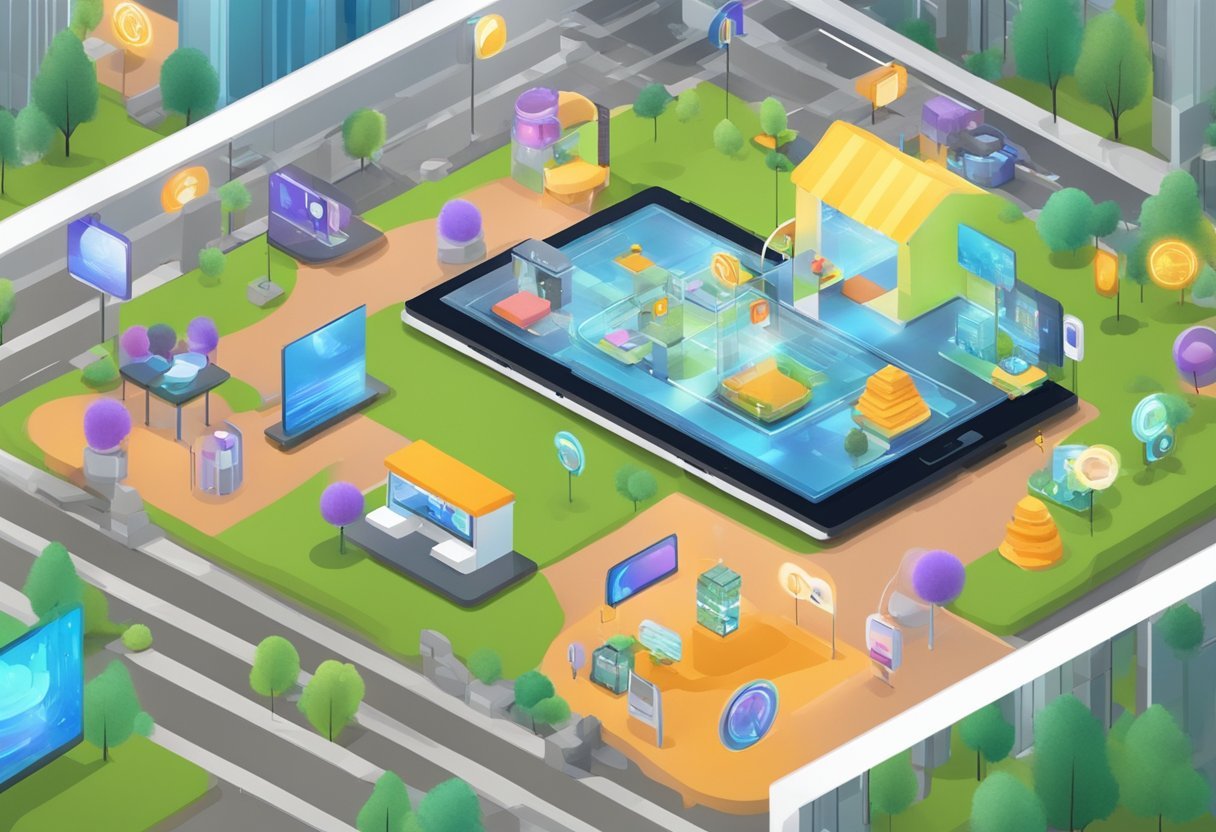Augmented reality (AR) has revolutionized the retail industry by providing customers with a unique and immersive shopping experience. AR technology overlays digital content onto the real world, allowing customers to visualize products in a 3D environment without having to physically interact with them. This technology has the potential to enhance the customer journey, increase sales, and improve customer satisfaction. In this blog post, I will share with you the concept of augmented reality in retail and how AR technology can be used in the retail space
The evolution of AR in retail has been rapid, with leading retailers finding ways to leverage the promise of virtual and augmented reality to deliver a vCommerce experience to customers. AR technology is changing how customers shop both online and in-store. Retailers can use AR technology to create interactive product displays, offer virtual try-ons, and provide customers with personalized recommendations based on their preferences and purchase history.
Evolution of Augmented Reality in Retail
From Virtual Reality to AR
Augmented reality (AR) has been around for quite some time now, and it has evolved significantly over the years. Initially, it was just a concept, but with the advancement of technology, it has now become a reality. AR technology has been used in various industries, including the retail industry. However, before AR became popular, virtual reality (VR) was the go-to technology for retailers.
VR technology allowed retailers to create virtual stores that customers could explore. However, the technology had its drawbacks. For instance, customers could not see how products looked in real life, and the experience was not immersive enough. This is where AR technology came in. AR technology allows customers to see products in real-life situations, and it is more immersive than VR technology.
Impact of the Pandemic on AR Adoption
The COVID-19 pandemic has had a significant impact on the retail industry. As a result, retailers have had to adapt to the new normal by adopting new technologies such as AR. According to a report by IBM, the pandemic has accelerated the shift to digital shopping by roughly five years. This means that retailers who were not prepared for the digital shift had to adapt quickly.
AR technology has been a game-changer for retailers during the pandemic. With AR technology, retailers can create virtual stores that customers can explore from the comfort of their homes. Customers can see how products look in real-life situations, and they can make informed decisions before making a purchase. AR technology has made it possible for retailers to offer a more immersive shopping experience, even when customers are not physically present in the store.
AR technology has come a long way since its inception. It has evolved from being a concept to becoming a reality. The pandemic has accelerated the adoption of AR technology in the retail industry, and it has become a game-changer for retailers. With AR technology, retailers can create immersive shopping experiences that customers will love.
Enhancing the Customer Journey
Augmented reality (AR) is revolutionizing the retail industry by enhancing the customer journey. AR technology provides customers with an immersive experience that enables them to interact with products in a more meaningful way. Retailers are leveraging AR to provide customers with a virtual try-on experience and in-store navigation and information.
Virtual Try-On Experiences
Virtual try-on experiences using AR technology are becoming increasingly popular in the retail industry. This technology allows customers to try on products virtually, such as clothes, accessories, and makeup. This feature provides customers with a better understanding of the product and how it will look on them before making a purchase.
AR-powered virtual try-on experiences have been shown to increase customer engagement and satisfaction. They provide customers with a more personalized and interactive shopping experience, which leads to increased customer loyalty and higher sales.
In-Store Navigation and Information
AR technology is also being used to enhance in-store navigation and product information. AR-powered apps can help customers navigate the store, locate products, and provide additional information about products.
In-store navigation using AR technology provides customers with a more seamless and efficient shopping experience. Customers can quickly locate products and receive real-time information about product availability and pricing.
AR-powered product information provides customers with a more immersive and engaging shopping experience. Customers can scan products using their smartphones to access detailed product information, reviews, and ratings. This feature provides customers with a better understanding of the product, which leads to increased customer satisfaction and sales.
AR technology is transforming the retail industry by enhancing the customer journey. Retailers are leveraging AR to provide customers with a more personalized and interactive shopping experience. AR-powered virtual try-on experiences and in-store navigation and information have been shown to increase customer engagement, satisfaction, and loyalty.
15 Ways Augmented Reality Work In Retail

- Virtual Try-Ons
- In-Store Navigation
- Interactive Product Displays
- AR Window Shopping
- Virtual Storefronts
- Product Customization
- AR-Driven Marketing Campaigns
- Immersive Product Catalogs
- Virtual Pop-Up Shops
- Enhanced Brand Storytelling
- Interactive User Manuals
- AR-Enabled Point of Sale
- Staff Training and Onboarding
- Inventory Management
- Customer Engagement and Feedback
Virtual Try-Ons
Virtual try-ons are a quintessential application of augmented reality in retail, allowing customers to visualize themselves wearing clothing, accessories, or cosmetics without physically trying them on. This technology uses AR to superimpose products onto the user’s image in real-time, providing a convenient and safe way to test fit, style, and color. Virtual try-ons can reduce the need for physical fitting rooms, minimize returns due to poor fit, and enhance the online shopping experience.
In-Store Navigation
Augmented reality in retail can significantly improve in-store navigation, guiding customers to the products they’re searching for with ease. By using their smartphone cameras, shoppers can follow AR directions overlaid on the store layout, making the shopping process faster and more efficient. This technology can also highlight promotions or products of interest based on the shopper’s preferences or past purchases.
Interactive Product Displays
Interactive product displays using AR can bring static items to life, providing customers with engaging information and demonstrations. Shoppers can scan products or displays to view 3D models, watch how-to videos, or see the product in different colors and variations. This interactive element can increase dwell time and enhance the overall shopping experience.
AR Window Shopping
Augmented reality in retail transforms window shopping by allowing passersby to interact with store displays through their smartphones. Retailers can showcase virtual product ranges, offer interactive experiences, or even allow customers to make purchases directly from the window display, creating a 24/7 shopping opportunity.
Virtual Storefronts
Virtual storefronts are an innovative use of augmented reality in retail, enabling customers to browse and shop in a fully digital environment. Brands can create immersive 3D stores that users can navigate through their devices, providing a unique shopping experience that transcends physical location and operating hours.
Product Customization
Product customization with AR allows customers to personalize products to their liking before purchasing. Shoppers can change colors, patterns, or components and see their customizations in real-time, ensuring the final product meets their expectations and increasing satisfaction.
AR-Driven Marketing Campaigns
Augmented reality in retail can make marketing campaigns more engaging by adding an interactive layer to traditional advertising. Customers can scan ads to unlock exclusive content, participate in virtual scavenger hunts, or access special offers, creating memorable brand interactions that drive sales.
Immersive Product Catalogs
Immersive product catalogs powered by AR provide customers with a dynamic browsing experience. Shoppers can view 3D models of products in detail, visualize items in their own space, and interact with products in ways not possible with traditional catalogs, leading to increased engagement and informed purchasing decisions.
Virtual Pop-Up Shops
Virtual pop-up shops are a flexible and cost-effective application of augmented reality in retail. Brands can launch temporary, location-based AR experiences that allow customers to shop limited edition collections or exclusive releases, generating buzz and excitement without the overhead of physical pop-up stores.
Enhanced Brand Storytelling
AR enhances brand storytelling by creating immersive narratives around products and brand values. Customers can scan products to unlock stories, meet the makers, or understand the craftsmanship involved, fostering a deeper connection between the consumer and the brand.
Interactive User Manuals
Interactive user manuals using AR can improve customer satisfaction post-purchase. Retailers can provide AR guides that show how to set up, use, or troubleshoot products, offering a more intuitive and user-friendly approach to customer support.
AR-Enabled Point of Sale
Augmented reality at the point of sale can provide customers with additional product information, reviews, or upsell opportunities as they make their purchase decision. This technology can also streamline the checkout process, offering a futuristic and efficient transaction experience.
Staff Training and Onboarding
AR in retail can revolutionize staff training and onboarding, providing interactive and immersive learning experiences. Employees can practice store operations, customer service scenarios, or product knowledge in a controlled virtual environment, leading to better preparedness and performance on the shop floor.
Inventory Management
Inventory management can be enhanced with AR by providing employees with real-time information about stock levels, product locations, and sales data. This can improve the efficiency of restocking, reduce the likelihood of out-of-stock situations, and optimize the product assortment.
Customer Engagement and Feedback
Augmented reality in retail can open new channels for customer engagement and feedback. Shoppers can leave virtual notes or reviews on products, participate in AR surveys, or interact with brand avatars, providing valuable insights and creating a two-way communication channel between the retailer and the consumer.
Integrating AR with Ecommerce Platforms
Augmented reality (AR) has become a popular tool for retailers to enhance customer engagement and improve the online shopping experience. By integrating AR with ecommerce platforms, retailers can provide customers with a more immersive shopping experience, allowing them to visualize products in a more realistic way. This section will explore the benefits of integrating AR with ecommerce platforms and how it can be done effectively.
Shopify and AR
Shopify is a popular ecommerce platform used by retailers to create online stores. It has recently added AR capabilities, allowing retailers to integrate AR into their online stores. With Shopify AR, retailers can create 3D models of their products and allow customers to view them in AR. This provides customers with a more realistic view of the product, allowing them to see how it would look in their home or environment.
Shopify AR also allows retailers to create AR ads, which can be displayed on social media platforms. This can help to increase customer engagement and drive traffic to the retailer’s online store. By integrating AR with Shopify, retailers can provide customers with a more engaging and interactive shopping experience, which can lead to increased sales and customer loyalty.
Social Media Integration
Social media platforms such as Facebook and Instagram have also added AR capabilities, allowing retailers to create AR ads and provide customers with a more engaging shopping experience. By integrating AR with social media platforms, retailers can reach a wider audience and increase customer engagement.
One example of social media integration is the use of AR filters. Retailers can create AR filters that allow customers to try on virtual products, such as makeup or clothing. This provides customers with a more realistic view of the product and can help to increase sales.
Integrating AR with ecommerce platforms can provide retailers with a range of benefits, including increased customer engagement, improved online shopping experience, and increased sales. By using platforms such as Shopify and social media platforms, retailers can effectively integrate AR into their online stores and reach a wider audience.
AR-Driven Marketing and Branding Strategies

Augmented reality has revolutionized the way retailers market their products and services. By leveraging AR technology, brands can create immersive shopping experiences that enhance brand awareness and boost customer engagement. In this section, we will explore two AR-driven marketing and branding strategies that retailers can use to drive sales and improve customer loyalty.
Creating Immersive Brand Experiences
One of the most significant advantages of AR in retail is its ability to create immersive brand experiences. By using AR technology, retailers can create virtual environments that allow customers to interact with their products in a more engaging and memorable way. For example, a furniture retailer could use AR to create a virtual showroom that allows customers to see how a particular piece of furniture would look in their home. This type of immersive experience not only helps customers make more informed purchasing decisions but also helps to build brand loyalty.
Leveraging User-Generated Content
Another effective AR-driven marketing and branding strategy is to leverage user-generated content. Social media platforms like Instagram and Snapchat have made it easier than ever for customers to create and share content related to their favorite brands.
By using AR filters and effects, retailers can encourage customers to create and share content that showcases their products in a fun and engaging way. This type of user-generated content not only helps to build brand awareness but also helps to create a sense of community around the brand.
AR technology has opened up new possibilities for retailers looking to improve their marketing and branding strategies. By creating immersive brand experiences and leveraging user-generated content, retailers can build stronger relationships with their customers and drive sales in the process.
Future Trends in AR for Retail
Augmented Reality (AR) has become an increasingly popular technology trend in the retail industry. With the rise of e-commerce and the need for a more interactive consumer experience, AR has proven to be a valuable tool for retailers. In this section, we will discuss some of the future trends in AR for retail, including advancements in AR technology and predicting consumer behavior.
Advancements in AR Technology
AR technology has come a long way in recent years, and it is only expected to improve. One of the most significant advancements in AR technology is the integration of Artificial Intelligence (AI). AI can help retailers personalize the consumer experience by offering customized product recommendations based on a customer’s preferences and past purchases. This can lead to increased customer satisfaction and loyalty.
Another advancement in AR technology is the integration of Virtual Reality (VR) and IoT. By combining AR, VR, and IoT, retailers can create a more immersive and interactive shopping experience. For example, customers can virtually try on clothing and see how it looks on them before making a purchase. This can lead to more informed purchasing decisions and reduce the number of returns.
Predicting Consumer Behavior
One of the most significant benefits of AR technology is its ability to predict consumer behavior. AR apps can track a customer’s browsing and purchasing history to offer personalized recommendations. This can lead to increased sales and customer satisfaction.
Another way AR can predict consumer behavior is through the use of data analytics. By analyzing customer data, retailers can identify trends and patterns in purchasing behavior. This can help retailers make informed decisions about product offerings and marketing strategies.
AR technology is expected to continue to play a significant role in the future of retail. Advancements in AR technology, such as the integration of AI and VR, will lead to a more personalized and interactive shopping experience. Predicting consumer behavior through the use of AR and data analytics can lead to increased sales and customer satisfaction.
Frequently Asked Questions

How are retailers integrating AR technology to enhance the shopping experience?
Retailers are integrating AR technology into their shopping experience by developing AR-powered mobile applications and in-store experiences. These applications allow customers to interact with products in a more immersive way by superimposing digital content on top of real-life objects. In-store AR experiences can be used to showcase products in a unique way, allowing customers to visualize products in their own space before making a purchase.
What are the proven benefits of augmented reality for retail businesses?
One of the biggest benefits of AR for retail businesses is the ability to enhance the customer shopping experience. AR technology allows customers to interact with products in a more immersive way, increasing engagement and ultimately leading to higher sales and revenue for the business. AR can also reduce the number of returns and improve customer satisfaction by allowing customers to visualize products in their own space before making a purchase.
Can you provide examples of successful AR implementations in retail?
One example of a successful AR implementation in retail is the IKEA Place app, which allows customers to visualize furniture in their own space before making a purchase. Another example is the Sephora Virtual Artist app, which uses AR technology to allow customers to try on makeup virtually before making a purchase.
What impact does AR have on consumer purchasing decisions in retail settings?
AR has been shown to have a positive impact on consumer purchasing decisions in retail settings. By allowing customers to interact with products in a more immersive way, AR can increase engagement and ultimately lead to higher sales and revenue for the business.
What challenges do retailers face when adopting augmented reality solutions?
One of the biggest challenges retailers face when adopting augmented reality solutions is the cost of development and implementation. AR technology can be expensive to develop and integrate into existing systems. Not all customers may have access to the necessary technology to use AR-powered applications.
How is the future of eCommerce being shaped by advancements in AR technology?
Advancements in AR technology are shaping the future of eCommerce by allowing customers to interact with products in a more immersive way. AR-powered applications can provide customers with a more personalized shopping experience, increasing engagement and ultimately leading to higher sales and revenue for the business. As AR technology continues to evolve, it is likely that we will see even more innovative uses of AR in the eCommerce space.




